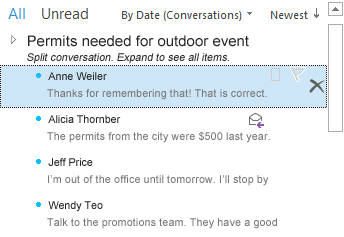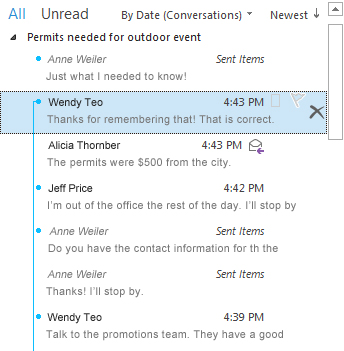View email messages by conversation
By default, when you add most account types to Outlook 2013, 2016, or Outlook for Office 365, your messages are displayed in Conversations. A conversation includes all messages in the same thread with the same subject line. Older versions of Outlook may not show conversation view enabled by default.
1. From any email folder, such as your inbox, click View > Show as Conversations to toggle Conversation view on or off.

2. Click All mailboxes or This folder.

Conversation that include multiple messages are identified in the message list by  . Click
. Click  to expand the Conversation.
to expand the Conversation.

Within each Conversation, messages are sorted with the newest message on top. You cannot change this sort order.

When you receive a new message that’s part of a Conversation, the whole Conversation moves to the top of your message list.
Any Conversation that includes unread messages has a bold subject and the count of the unread messages appears next to the subject. When you click to expand the Conversation, any unread message has a bold heading.
Change Conversation options
There are several conversation options you can change.
1. From any email folder, such as your inbox, click View > Conversation Settings

2. Select any of the available options.
- Show Messages from Other Folders Use this option to display messages in the conversation that have been moved to other folders as well as messages you've sent that are stored in your Sent Items folder.
- Show Senders Above the Subject Selecting this option shows the sender names at the top of the conversation rather than the conversation subject.
- Always Expand Selected Conversation This option applies only to the currently selected conversation. The conversation selected when you check this box will always appear expanded.
- Use Classic Indented View Classic indented view shows messages in the conversation indented based on their position within the conversation.

